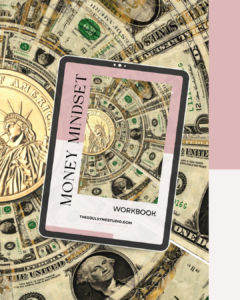Your path to financial success begins in your mind, not in your bank account. As Wayne Dyer wisely notes, “Abundance is not something we acquire. It is something we tune into.” Your money mindset, the beliefs you hold about wealth and scarcity, influences every decision. Whether you see opportunities or obstacles depends on the stories your brain tells about money.
Napoleon Hill, author of Think and Grow Rich, emphasizes: “Wealth is largely the result of habit.” This indicates that financial abundance is not random. It grows from daily choices made with a wealth mindset. But what if traditional budget tips or side hustles never stick? That’s because they overlook the deeper layer: the invisible patterns of your money mindset.
Imagine unlocking financial success by rewiring your thoughts, not by chasing dollars. This article uncovers why your current money beliefs might block growth. It shows how shifting your perspective can turn obstacles into stepping stones. Whether you’re earning $30k or $300k, your wealth mindset determines whether you stay stuck or achieve lasting financial success. Are you ready to start tuning into abundance?
Understanding Your Current Money Mindset and Its Impact
Your current money mindset is influenced by decades of hidden messages from early life. Consider the phrases your family used about money, such as “We can’t afford that” or “Money is stressful.” These messages shape your money story, a guide for your spending, saving, and risk-taking today. Many people unknowingly hold limiting money beliefs that act as financial blocks to abundance.
“Your relationship with money begins long before your first paycheck,” says behavioral finance research. “Childhood lessons become invisible roadmaps for adult decisions.”
A mindset assessment uncovers these patterns. Ask yourself: Do you hesitate to invest? Fear success? Blame luck for financial setbacks? These signs might indicate beliefs like “I don’t deserve wealth” or “Rich people are greedy.” Such beliefs not only slow progress but also trap you in cycles of scarcity.
Consider a client who avoided raises for years, convinced they’d “lose it all anyway.” Their financial blocks came from watching a parent lose savings in a recession. By rewriting their money story, they transitioned from survival mode to strategic planning. Awareness is the first step towards financial freedom.
Breaking Free From Scarcity Thinking About Money
Financial fear often traps you in a scarcity mindset, making abundance seem unattainable. Recognizing this cycle is the first step towards freedom. When you find yourself holding onto every dollar or avoiding investments due to doubt, it’s your scarcity mindset at play. These behaviors—such as extreme frugality, avoiding budgeting, or believing there’s never enough—are mental traps that hinder growth.
“Scarcity whispers ‘not enough,’ but abundance shouts ‘what’s possible.’”
Abundance thinking begins by challenging these patterns. Ask yourself: Does this thought align with my goals? Replace thoughts like “I can’t afford it” with “How can this help me grow?” A mindset workbook can guide this transformation. By tracking your triggers in writing—when do you feel anxious about money?—you can identify and reframe money blocks into opportunities.
 Ready to shift your mindset and start attracting unlimited wealth? 💰✨ This powerful workbook will help you reprogram your subconscious, break free from limiting money beliefs, and easily manifest financial freedom. Your abundant life is waiting – Download Your Copy Now and start manifesting money today!
Ready to shift your mindset and start attracting unlimited wealth? 💰✨ This powerful workbook will help you reprogram your subconscious, break free from limiting money beliefs, and easily manifest financial freedom. Your abundant life is waiting – Download Your Copy Now and start manifesting money today!
Embrace small shifts daily. Celebrate moments when you choose courage over fear. Every time you invest in your future instead of hoarding, you weaken scarcity’s grip. This practice turns abundance thinking into a habit, not just a goal. Your mindset workbook becomes your roadmap, turning doubt into actionable steps.
Remember, abundance isn’t just about wealth—it’s a perspective. Let go of the belief that success for others means loss for you. With awareness and practice, you can transform financial fear into confidence. The journey starts now, one mindful choice at a time.
Powerful Strategies to Develop an Abundance Money Mindset
Creating an abundance money mindset requires daily habits that alter your financial trajectory. Start each day with money affirmations like “Prosperity flows easily into my life.” This helps to replace negative thoughts with positive ones. Spend a few minutes each day visualizing your goals, such as owning a dream home or starting a business. This practice, known as wealth visualization, strengthens your subconscious connection to success.

Surround yourself with resources that support mindset transformation. Listen to podcasts or read books by financial gurus like T. Harv Eker. His teachings on abundance mindset have empowered countless individuals. Swap out media that focuses on scarcity for content that celebrates financial growth. This includes stories of entrepreneurs who turned their limitations into opportunities.
“Your thoughts create your reality. Choose thoughts of abundance.”
Keep track of your progress with a journal. Note how small decisions, like saving 10% of your income or networking with ambitious peers, influence your mindset. Replace phrases like “I can’t afford that” with “How can I make this possible?” This mindset shift turns abstract ideas into concrete steps toward financial growth.
Creating Your Personal Money Mindset Workbook for Lasting Change
Your money mindset workbook is a guide to changing your wealth perception. Begin by creating a financial vision statement that embodies your values and financial aspirations. Write it as if your goals have already been met, aligning your money beliefs with abundance.
Make your workbook a daily tool for tracking your progress. Incorporate mindset practices like morning affirmations and evening reflection. Record instances of financial confidence to combat negative thoughts. Allocate a section for mindset tracking—document shifts in your money perception, such as reduced anxiety or bold financial decisions.
Establish routines that foster growth. Keep gratitude lists for financial blessings, no matter how small. Visualize success weekly by sketching scenarios where your goals are a reality. Update your financial vision statement as you grow, ensuring it remains relevant to your journey.
This workbook is more than a journal—it’s a tool for solidifying your commitment. By recording successes and setbacks, you strengthen neural pathways for wealth. Each entry reinforces the belief that your goals are attainable, turning thoughts into actions. Your money mindset workbook becomes a living testament to your transformation, guiding you toward lasting financial freedom.
Conclusion: Embracing Your Journey to Financial Freedom Through Mindset Transformation
Your path to financial freedom starts with a simple step: changing your money mindset. Every decision to embrace a wealth mindset moves you closer to abundance. This transformation isn’t about quick fixes—it’s about steady progress. Acknowledge each victory, no matter how small, as proof of your journey’s advancement.
Setbacks are inevitable. When doubts creep in, recall the strategies you’ve learned. Overcoming scarcity thinking requires effort, but each attempt strengthens your mindset. Envision a life where financial stability empowers your passions and generosity. This vision is within reach, growing with every deliberate choice you make.
Financial freedom transcends mere numbers; it’s about the peace of controlling your narrative. Begin by integrating one new habit from this guide into your life. Record small victories, revisit affirmations, or tweak your spending habits. Each action cultivates lasting change. The path to abundance is yours to tread, step by step.
Envision the possibilities when your mindset aligns with abundance. You’re no longer bound by outdated patterns—you’re crafting a future where money serves you. This is your turning point. Start today, and witness how a transformed mindset turns dreams into realities. Your journey to financial freedom begins now, with each mindful decision.



